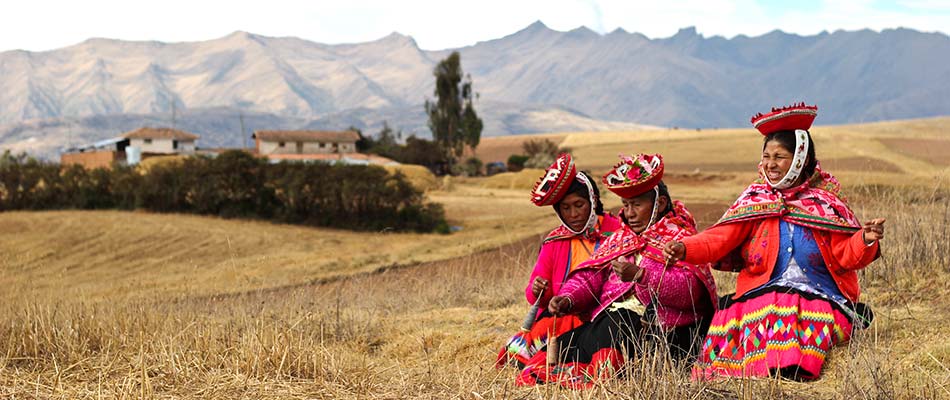Quechua women's dress today is rooted in traditions from pre-conquest Peru (a fusion of Inca and Huari cultures), and Spanish Colonial peasant dress (often with some modern touches).
In the Peruvian High Andes, each village has a unique style of clothing that identifies the wearer as belonging to that region. Indigenous women in the Andes dress in layers of bright, colorful traditional Andean clothing, including capes, shawls, embroidered skirts, and vibrantly colored hats. However many women dress in modern clothing these days, and wear their traditional garb for special occasions. Increasingly, young women who live in Cusco and other urban centers choose to wear modern clothing, but may revert to traditional Andean clothing when back in their villages.
Lliclla
Lliclla is a Quechua word for a type of cape worn by Quechua women, also known as a Manta. A lliclla is a square woven cloth that covers the back and shoulders. It is secured at the front using a tupu (straight pin), a sturdy safety pin, or may be worn tied. When folded and pinned about the shoulders it acts as a small heavy shawl, which keeps the women warm in the chilly Andean air.

Llicilas are intricately woven and colorfully decorated for festivals and other special occasions, during which women may wear multiple layers of Llicilas.
Llicilas or mantas can also be used for carrying children on the woman's back. Both women and men use these in the same way for carrying cargo. Some call larger mantas k'eperinas when used for carrying loads. Traditionally, wool jackets decorated with colorful patterns of buttons were worn under the Lliclla, but nowadays it is more common to see women wearing sweaters or cardigans under their Lliclla.
Chumpi
A Chumpi (a Quechua term meaning belt) is traditionally worn by women to fasten their skirts. Chumpis are also worn by men as a means of supporting the lower back when carrying heavy loads, and to tie their pants. Chumpis are also used to secure swaddled infants. Many weavers make chumpis to sell at market.
Jobona
Jobona is a Quechua word for a traditional wool jacket, worn by women, that is adorned with patterns of colorful buttons, and worn under the Lliclla.
Monteras
Montera is a Quechua word for a traditional hat, which varies in style depending on the region. The sanq'apa is a woven strap decorated with a heavy layer of (predominantly white) beads, that ties the hat under the chin. The number of beads generally reflects the social status of the woman.

Many women buy their hats in the market, and choose to decorate them in their own manner using sequins, flowers, safety pins, or bric-a-brac. It is often possible to identify the village or region that the women come from by the type of hat she wears.
Polleras
Polleras are wide skirts, traditionally made from handwoven wool bayeta cloth (but now often machine made and purchased). Women usually wear several of these on top of one another, and on special occasions women may wear up to 10 or more of them at a time!

Skirts are usually trimmed with a colorful band, called a puyto, which is often applied by hand to a purchased skirt. These puyto can vary from a subtle, narrow band with one or two colors, to a wide, multi-colored band which covers most of the skirt. The style of the pollera is often an indicator of where a woman is from. The above photo depicts women from Rumira Sondormayo wearing slightly different types of polleras.
Hojotas
Hojotas are sandals made from recycled tires. When foreigners first see the Andean people wearing these sandals, they often think that it would be better for them to wear shoes and socks, but the Andean people are very comfortable in these sandals and their feet are well-adapted to the cold conditions.
Men's Dress
Men's traditional Andean clothing has been more eroded by Western contact than women's dress, and younger Andean men now mostly wear Western-style clothing, such as sports clothing and baseball caps. Many elderly men wear knee-length, dark handwoven pants. In the Patacancha region, the men wear beige or white bayeta pants. Knee length pants are much more practical for working in the fields; these days it's common to see young men wearing modern sweat pants rolled up to the knees.

